
Dominique Prinsloo
Project Manager
How can you ensure your online plant purchases are ethical, legal, and sustainable?
In recent years, the ornamental houseplant trade has bloomed. The convenience of buying plants online has made it easier than ever before to bring nature, often rare nature, indoors. Many buyers probably aren’t aware of the ethical, sustainable, and legal dimensions that underpin this trade. Many don’t realise that the availability of some plants online may be threatening the survival of the species in the wild.
Rather than being grown in nurseries, many increasingly popular ornamental plants are plucked from their natural habitats. This practice not only leads to species loss but also contributes to habitat destruction, affecting the vital services these plants provide to our ecosystems. The consequences of this go beyond our living rooms, impacting entire landscapes and the livelihoods of communities that depend on them.
Cycads, orchids, cacti, and other succulents are among the many plant groups bought online. For plant lovers, the challenge is clear: how do we fill our homes with mood-boosting greenery, without unwittingly supporting an unethical, unsustainable, and illegal trade?
Before making a purchase, take a moment to consider these four essential questions:
1. Was this plant sourced from the wild or was it nursery grown/propagated?
You might be thinking, “How can I tell if a plant was taken from the wild as opposed to grown in a nursery”? Well, there are clues:
- Shape and form: Plants with non-uniform/irregular shapes and appearances that look worn out are easy to spot and tend to be sourced from the wild. This is in comparison to well-manicured, regular shaped plants, which tend to be nursery-grown.
- Marks or scars: Plants harvested from the wild often bear signs of their natural growing environments, such as markings or scars from natural sources such as fire, herbivory, rain, wind, and more.


Nursery grown succulents tend to look well-manicured, whereas those taken from the wild might look damaged from environmental conditions or the harvest process. |
- Age and size: Many ornamental plant species, including cycads and caudiciform succulents take time to mature, and large specimens could be an indication that such plants are wild harvested. Other species, like the Conophytum dwarf succulents, may only bloom once they reach a few years old. Keep an eye out for seed capsules and flower buds in a clump of Conophytum; this might indicate that it was wild-harvested.

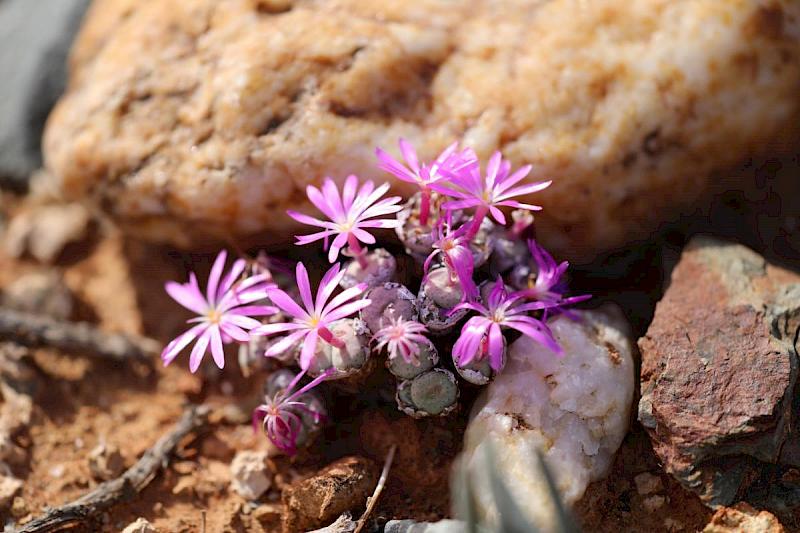
Conophytum succulents may only bloom once they are a few years old. Right photo: |
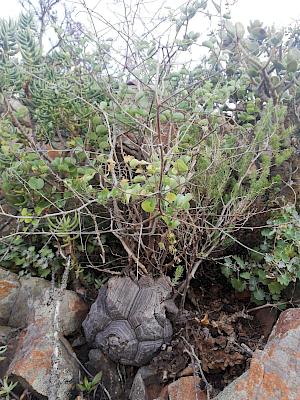
Imagine waiting 50 years to reach adulthood! That's the case for the Elephant’s Foot plant, which can grow to an impressive size—often more than 3 meters in circumference and nearly a meter in height above ground! Spotting this size in captivity is rare, so this might indicate that it was harvested from the wild. If you come across mature plants for sale, don’t hesitate to ask when they were planted, if they came from mother stock (Mother plants are stock plants that are either plants in the wild or plants specifically raised to provide cuttings for starting new plants), and if the seller obtained them legally with the necessary permits.
- Change in form: if a plant shows a change in form, this could reveal that it has transitioned from the wild to a pot. Take cycads, for instance; their form is affected by their natural habitat, such as access to sunlight, rocks, cliffs, etc. However, in captivity, they may stand tall and upright because they grow in a bag or pots or because they grow in the direction of artificial light.

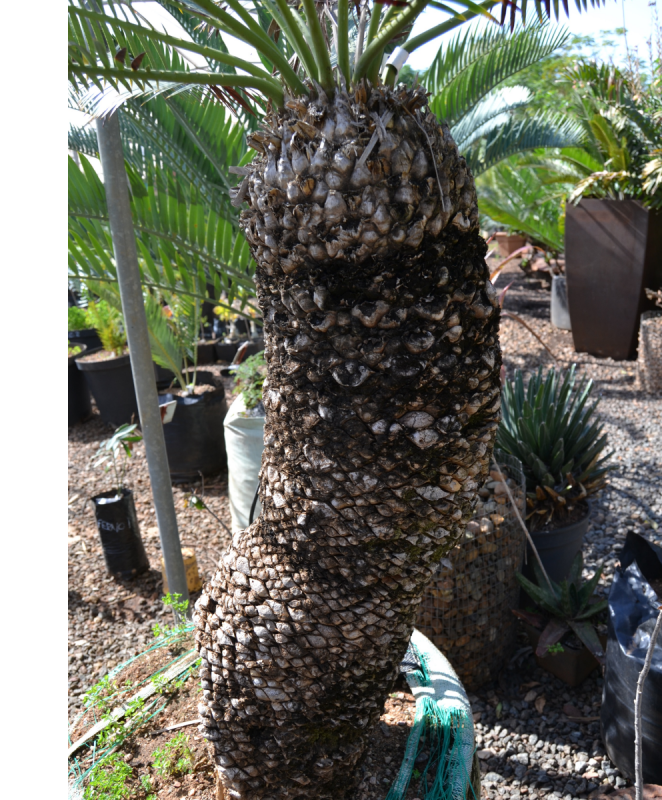
The cycad on the right has grown in the wild, indicated by the slightly crooked shape of its stem. Cycads grown in nurseries (left) tend to grow straight and are often smaller because they grow slowly. Photos © Z. Zondi |
- Roots: Roots grow according to the substrate or where the plant has grown. Plants taken from the wild will have their roots cut or torn from the growing substrate–for example, an orchid growing on a branch will have roots that will follow the shape of the branch, and an orchid growing around rocks will have roots that follow the shape of the rocks. By comparison, an orchid grown under controlled conditions will have full, healthy, uncut roots that will reflect the shape of the pot it was growing in. Orchids, such as this Dendrobium, are often so strongly attached to the substrate they are growing on that the bark remains attached to the roots when the plant is torn loose.
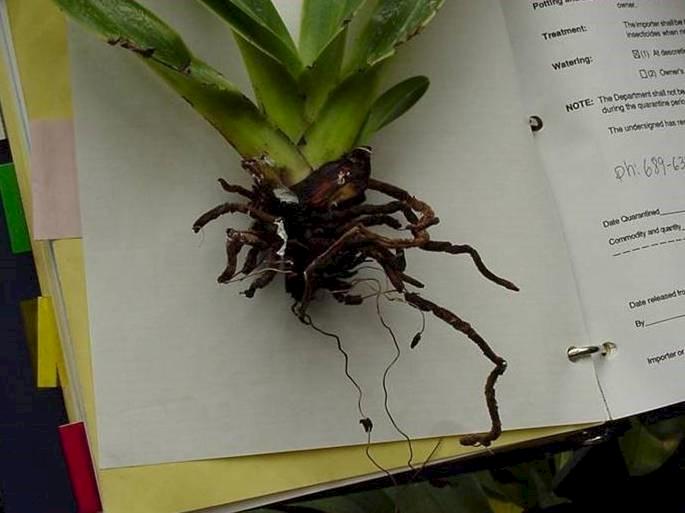
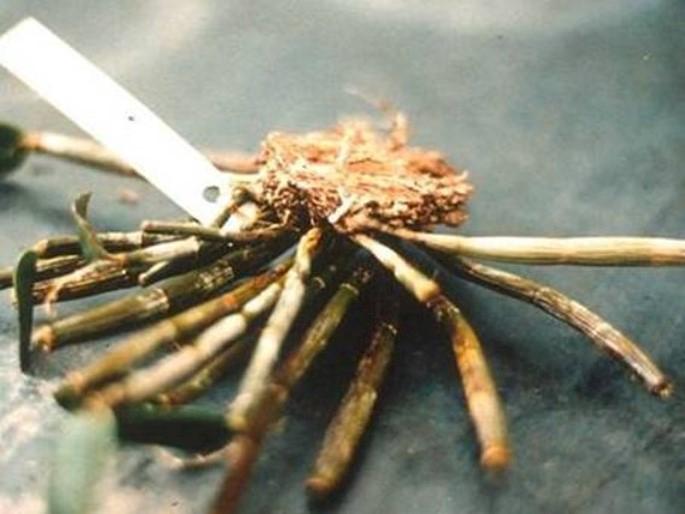
Left: Wild-collected Paphiopedilum with dead roots | Right: Wild-collected Dendrobium with roots attached to bark © CITES Secretariat |
Of course, some of these signs might be hard to spot in online photos, but feel free to contact the seller directly to ask about the source of their plants.
2. Is this plant protected by any domestic or international legislation?
Most countries have a list of plants that are protected domestically through local, provincial, and national legislation. If you’re interested in purchasing protected plants, you need to be aware of your country’s laws to avoid criminal proceedings or penalties.
At an international level, many plant species are listed on Appendix I, II, or III of the Convention on the International Trade in Endangered Species of Wild Fauna and Flora (CITES), a treaty signed by over 180 countries to protect wild species in international trade.
Appendix I is crucial for protecting species on the brink of extinction, with commercial trade in wild specimens strictly prohibited, except under exceptional circumstances. Moving plants of species listed in the CITES Appendices (and in many cases, their seeds) across international boundaries requires permits to ensure trade won’t jeopardise the species' survival. If you intend to trade plants listed in the CITES Appendices, familiarise yourself with the conditions associated with each Appendix. If purchasing plants online, buying from local rather than overseas sellers avoids the need for CITES permits, and reputable traders should be happy to answer any questions about the origin of their plants and how they were sourced, which you can ask them before heading for the checkout.
3. Is this plant known to be threatened by trade?
Buying plants online that were wild harvested without the correct permissions in place may put their populations at risk, especially those already listed as Vulnerable, Endangered, Critically Endangered, or Extinct In The Wild on the IUCN Red List of Threatened SpeciesTM.
Before purchasing a plant, paste its scientific name into the portal search bar of the IUCN Red List portal to check its status. You’ll find information on trade threats, range, population size, habitat, ecology, and more. Steer clear of purchasing plants that are threatened unless you are certain that they are not wild-harvested.
Take a moment to make an informed decision before clicking that buy button!
4. Can you be sure the harvesting of this plant isn’t putting people at risk?
In some cases, criminal syndicates exploit local communities by hiring them to illegally harvest plants from the wild. These workers are often paid significantly less than the plant’s value, and it’s been documented that, in some cases, they are paid in drugs. These criminal networks may also engage in trafficking other commodities and may be tied to corruption. To ensure a legal and sustainable stream of income for local communities, it’s best to buy plants from certified nurseries which have the right permits.
However, determining this from online plant adverts can be challenging. Look for certifications from trusted independent bodies such as FairWild, Fairtrade Flowers and Plants, and Wildlife Friendly Enterprise Network.
Reporting illegal plant trade
If you suspect that plants are harvested illegally, report it to the commerce platform you are using. Some platforms, like eBay and Etsy, prohibit the sale of Endangered plant species, and users can report adverts to their compliance and monitoring teams. Companies such as eBay, Etsy and many others are working with the Coalition to end Wildlife Trafficking online, joining forces with the world’s biggest e-commerce, technology, and social media companies in partnership with wildlife experts at WWF, TRAFFIC, and IFAW to shut down online marketplaces for wildlife traffickers.
The impact of ethical plant purchases
Why should you care? Imagine purchasing a plant that requires a CITES permit. Without the correct permit, your plant parcel could be confiscated upon arrival at its destination country, resulting in the loss of both the parcel and your money. Your details might need to be shared with law enforcement, triggering an investigation into the buyer. It’s in your best interest to ask these questions before buying the plants.
Beyond personal consequences, wildlife crime is a murky business, often run by dangerous international networks that are linked to other serious smuggling crimes. As the largest direct threat to many of the world’s most threatened species – second only to habitat destruction in overall threats against species survival – stamping out wildlife crime is a priority to protect landscapes, species, and the people who live among them.
For those who value nature, I would encourage you to take this advice when buying plants online. Choose plants from reputable sellers and lend your support to initiatives that ensure that plants are sourced ethically, sustainably and legally. Together, we can ensure a thriving future for wild plant populations and people.
Notes:
Each of South Africa’s nine provinces has a list of specially protected or protected plant species (have a look at the Western Cape Province’s Nature Conservation Ordinance No. 19 of 1974 as an example – page 30, 31 and 32 to be exact!). Should you wish to trade in these plants, you may need to retain the proof of origin (such as a nursery receipt or letter confirming that it was donated or gifted to you) and apply for a permit to purchase the plant or transport it across provincial boundaries. This ordinance also tells you the penalties should you not comply with the regulations.
Find out more on TRAFFIC's project funded by the UK’s Department for Environment, Food & Rural Affairs (Defra) Illegal Wildlife Trade Challenge Fund (IWTCF) called “Harnessing technology to end the illegal trade in succulent plants”


